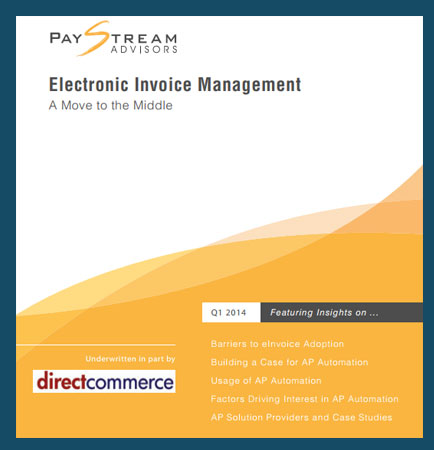
PROCESSING. PLEASE WAIT...



White Paper: Direct Commerce
As the electronic invoicing market becomes more saturated in large companies, the small and medium enterprise (SME) market, those with annual revenues under $250 million, continue to open up. Over the past year, PayStream analysts witnessed an increase in electronic invoice (eInvoice) adoption among SME’s, as well as an increase in workflow automation. New and improved innovations in eInvoice functionality including Software-as- a-Service (SaaS), free supplier portals, dynamic discounting and mobile transactional capabilities are the driving forces behind the increase in adoption in the middle market. More SMEs are now reaping the benefits that the large early adopters did, including reduced processing costs, increased invoice approval cycle times, improved cash management, and increased visibility, to name a few. In addition to more companies or (buyers) implementing eInvoicing, PayStream survey results reveal that eInvoice adoption has been of keen interest among suppliers. The number of suppliers that no longer submit paper invoices and have converted to eInvoicing has increased dramatically. Today more suppliers send more invoices to companies in electronic format that do not require data entry, resulting in a more efficient and cost saving invoice process. Solution providers are now catering to suppliers with aggressive supplier on-boarding programs and easy to use supplier portals. More eInvoicing providers are offering their services to suppliers at no-cost, in an effort to build their supplier networks and keep buyers and suppliers connected across the globe.
By: Quantum
Hybrid Cloud storage has features of both Public and Private Cloud implementations, connected at various points to allow business users and applications to access storage via either of the two infrastructures as determined by IT or corporate policy. Moving data to the cloud is actually cheaper, can be expanded interminably and needs less attention; but how much data can a company realistically park in cloud storage? With an effective Hybrid Cloud storage solution, you can choose the best match for your workload requirements at any time, and rebalance them as your needs change. This whitepaper provides insights on how the promise of the cloud is playing out, both positively and negatively, through its various implementations. In this whitepaper, the main focus is on cloud storage. It highlights: Immediate and long-term benefits of different cloud models Potential downsides of the cloud models Different cloud storage options available Finding which of the cloud storage options is the best
By: Hitachi Data Systems
Digital transformation isn't just a biggest challenge; it's also the best opportunity for IT pioneers. Data-driven digital transformation has the potential not only to address competitive threats posed by insurgents, but also to uncover opportunities for new business models and revenue streams. The key is for established companies to unlock the full potential of this important resource to fuel digital transformation and help to maintain their leadership positions in volatile and quickly evolving markets. This whitepaper provides insights on how to turn digital transformation from a challenge to a data-defined opportunity and the advantage offered by enterprise data. Key takeaways from this whitepaper: The Business Benefits of Digital Transformation The Top Considerations for CIOs, including advice from IT pioneers Five Keys to Digital Transformation Success


 2024 All Rights Reserved | by: www.ciowhitepapersreview.com
2024 All Rights Reserved | by: www.ciowhitepapersreview.com